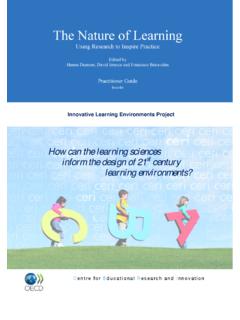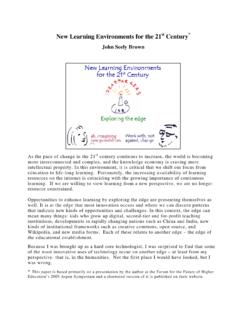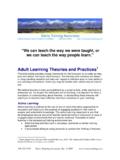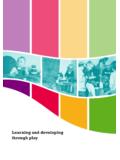Transcription of 10 - David Lewis, PhD
1 ! ! I 1 I 10 Design i ng Constructivist learning Environments1 David Jonassen Pennsylvania State University David Jonassen David Jonassen is Professor of Instructional Systems at Pennsylvania State University. He previously taught at the University of Colorado, the University of Twente, the University of North Carolina at Greensboro, Syracuse University, and Temple University, and has con-sulted with businesses, universities, and other institutions around the world. He is working on his twentieth book and has written numerous articles, papers, and technical reports. His current research focuses on designing constructivist learning environments, cognitive tools for learning , knowledge representation formalisms, problem solving, computer-supported collaborative argumentation, and individual differences and learning .
2 'In order to conform to the structure of this book, the design of constructivist learning environments (CLEs) is described conceptually in an objectivist way in this chapter. That is not my preference. In my classes, students define or accept a problem first and learn how to design CLEs in the context of that problem. However, any competent objectivist instruction (including this chapter) is obligated to provide examples. Page limitations prevent this, as well as a full elaboration of the model and its theoretical foundations. So CLE prototypes and environments can be exarnined elsewhere ( ). 215 216 JONASSEN FOREWORD Goals and preconditions. The primary goal of this theory is to foster problem solving and conceptual development. It is intended for ill-defined or ill-structured domains. Values.
3 Some of the values on which this theory is based include: learning that is driven by an ill-defined or ill-structured problem (or ques-tion, case, project), a problem or learning goal that is "owned" by the learner, instruction that consists of experiences which facilitate knowledge construc-tion (meaning making), learning that is active and authentic. Methods. Here are the major methods this theory offers: I. Select an appropriate problem (or question, case, project)for the learning to focus on. The problem should be interesting, relevant and engaging, to foster learner ownership. The problem should be ill-defined or ill-structured. The problem should be authentic (what practitioners do). The problem design should address its context, representation, and manipu-lation space. 2.
4 Provide related cases or worked examples to enable case-based reasoning and enhance cognitive flexibility. 3. Provide leamer-selectable information just-in-time. Available information should be relevant and easily accessible. 4. Provide cognitive tools that scaffold required skills, including prob-lem-representation tools, knowledge-modeling tools, performance-support tools, and information-gathering tools. 5. Provide conversation and collaboration tools to support discourse communi-ties, knowledge-building communities, and/or communities of learners. 6. Provide social/contextual support for the learning environment. This theory also offers the following instructional activities to support learning : A. Model the performance and the covert cognitive processes. B. Coach the learner by providing motivational prompts, monitoring and reg-ulating the leamer's performance, provoking reflection, and/or perturb-ing learners' models.
5 C. Scaffold the learner by adjusting task difficulty, restructuring the task, and/or providing alternative assessments. Major contribution. The integration of much work in the constructivist arena into a coherent instructional framework. 10. DESIGNING CONSTRUCTIVIST learning ENVIRONMENTS Design i ng Constructivist learning Environments INTRODUCTION 217 Objectivist conceptions of learning assume that knowledge can be transferred from teachers or transmitted by technologies and acquired by learners. Objectivist con-ceptions of instructional design include the analysis, representation, and resequencing of content and tasks in order to make them more predictably and reli-ably transmissible. Constructivist conceptions of learning , on the other hand, assume that knowl-edge is individually constructed and socially coconstructed by learners based on their interpretations of experiences in the world.
6 Since knowledge cannot be trans-mitted, instruction should consist of experiences that facilitate knowledge con-struction. This chapter presents a model for designing constructivist learning environments (CLEs) that engage learners in meaning making (knowledge con-struction). For an elaboration of the assumptions and beliefs on which CLEs are based, see Duffy and Jonassen (1992); Jonassen (1991, 1995a, 1995b, 1996a); Jonassen, Campbell, and Davidson (1994); Jonassen, Peck, and Wilson (1998); and Savery and Duffy (1996). While objectivism and constructivism are usually conveyed as incompatible and mutually exclusive, that is not an assumption of this chapter. Rather, I believe that objectivism and constructivism offer different perspectives on the learning process from which we can make inferences about how we ought to engender learning .
7 The goal of my writing and teaching is not to reject or replace objectivism. To impose a single belief or perspective is decidedly nonconstructivist. Rather, I prefer to think of them as complementary design tools (some of the best environments use combi-nations of methods) to be applied in different contexts. * MODEL FOR DESIGNING CONSTRUCTIVIST learning ENVIRONMENTS The model for designing CLEs (Fig. ) illustrates their essential components. The model conceives of a problem, question, or project as the focus of the environ-ment, with various interpretative and intellectual support systems surrounding it. The goal of the learner is to interpret and solve the problem or complete the project. * This diversity of perspectives and methods is an important aspect of the new paradigm of instruc-tional theories.
8 218 JONASSEN Related cases and information resources support understanding of the problem and suggest possible solutions; cognitive tools help learners to interpret and manipulate aspects of the problem; conversation/collaboration tools enable communities of learners to negotiate and coconstruct meaning for the problem; and social/contex-tual support systems help users to implement the CLE. 1. Question/Case/Problem/Project The focus of any CLE is the question or issue, the case, the problem, or the project that learners attempt to solve or resolve. It constitutes a learning goal that learners may ac-cept or adapt. The fundamental difference between CLEs and objectivist instruction is that the problem drives the learning , rather than acting as an example of the con-cepts and principles previously taught.
9 Students learn domain content in order to solve the problem, rather than solving the problem as an application of learning . ---,.,,..:..,.-:---,---:-_ "'~-~--I--+--I~ C. Scaffolding FIG. Model for designing CLEs 10. DESIGNING CONSTRUCTIVIST learning ENVIRONMENTS 219 CLEs can be constructed to support question-based, issue-based, case-based, pro-ject-based, or problem-based learning . Question-or issue-based learning begins with a question with uncertain or controversial answers ( , Should welfare recipients be required to work? Should environmental protection seek to eliminate pollution or regulate according to location-sustainable standards?). In case-based learning , stu-dents acquire knowledge and requisite thinking skills by studying cases ( , legal, medical, social work) and preparing case summaries or diagnoses.
10 Case learning is anchored in authentic contexts; learners must manage complexity and think like prac-titioners (Williams, 1992). Project-based learning focuses on relatively long-term, integrated units of instruction where learners focus on complex projects consisting of multiple cases. They debate ideas, plan and conduct experiments, and communicate their findings (Krajcik, Blumenfeld, Marx, & Soloway, 1994). Problem-based learn-ing (Barrows & Tamblyn, 1980) integrates courses at a curricular level, requiring learners to self-direct their learning while solving numerous cases across a curricu-lum. Case-, project-, and problem-based learning represent an approximate contin-uum of complexity, * but all share the same assumptions about active, constructive, and authentic learning . CLEs can be developed to support each of these, so for pur-poses of this chapter, which seeks to present a generic design model, I will refer to the focus of the CLEs generically as a problem.






